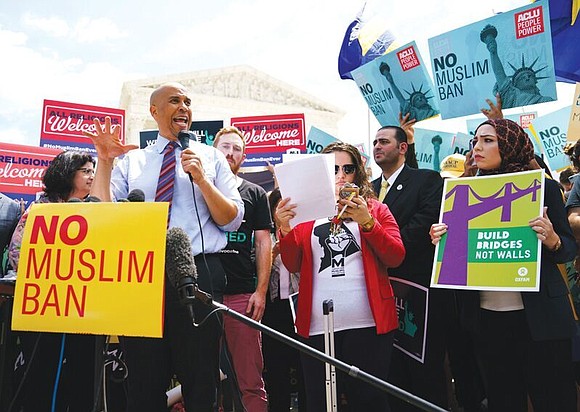Muslim travel ban upheld by U.S. Supreme Court
7/1/2018, 11:24 a.m.

WASHINGTON
The U.S. Supreme Court on Tuesday handed President Trump one of the biggest victories of his presidency, upholding his travel ban targeting several Muslim-majority countries and rejecting the argument that it represented unconstitutional religious discrimination.
The 5-4 ruling, with the conservative justices in the majority and the liberal justices dissenting, ended a fierce fight in the courts over whether the policy amounted to an unlawful ban on Muslims, while also confirming broad presidential powers over immigration and national security policy.
The ban prohibits entry into the United States of most people from Iran, Libya, Somalia, Syria and Yemen.
While President Trump quickly claimed “profound vindication,” a host of Muslim advocacy groups, religious groups and civil rights organizations lambasted the decision. The ruling also was met by a large group of protesters outside the U.S. Supreme Court on Tuesday.
Nihad Awad, executive director of the Council on American-Islamic Relations, called the decision “disappointing to Muslims and all Americans who believe in equal protection and equality.”
He argued that it gives the Trump administration “a free hand to re-inject discrimination against a particular faith back into our immigration system, which was rejected more than 50 years ago.”
“The ruling will go down in history as one of the Supreme Court’s great failures,” said Omar Jadwat, a lawyer for the American Civil Liberties Union, which challenged the ban.
Lower courts had blocked the travel ban, which was announced in September, as well as two prior versions, in legal challenges brought by the state of Hawaii and others.
President Trump has called the travel ban necessary to protect the United States against attacks by Islamic militants.
Many believe the ruling to be empowering to President Trump at a time when he is embroiled in controversy over his approach toward illegal immigration along the U.S.-Mexico border. Last week, he retreated from his administration’s practice of separating the children of migrants from their parents when families are detained after entering the United States illegally.
On Tuesday, the court held that the challengers failed to show that the travel ban violated either U.S. immigration law or the U.S. Constitution’s First Amendment prohibition on the government favoring one religion over another.
In remarks at the White House, President Trump hailed “a tremendous victory for the American people and for our Constitution.”
“We have to be tough, and we have to be safe, and we have to be secure. At a minimum, we have to make sure that we vet people coming into the country,” he said, referring in a statement to “this era of worldwide terrorism and extremist movements bent on harming innocent civilians.”
U.S. Sen. Bob Menendez, the top Democrat on the Senate Foreign Relations Committee, said, “Despite today’s ruling, turning away those fleeing horrific violence and persecution or to discriminate against people based on nationality and religion continues to be as un-American as ever.”
Writing for the court, Chief Justice John Roberts said that the Trump administration “has set forth a sufficient national security justification” to prevail. “We express no view on the soundness of the policy,” the chief justice added.
The ruling affirmed broad presidential discretion over who is allowed to enter the United States. President Trump could potentially add more countries to the ban.
Justice Roberts said President Trump’s actions suspending entry of certain classes of people were “well within executive authority and could have been taken by any other president — the only question is evaluating the actions of this particular president in promulgating an otherwise valid proclamation.”
The challengers argued that the policy was motivated by President Trump’s enmity toward Muslims and urged courts to take into account his inflammatory comments during the 2016 presidential campaign. As a candidate, he called for “a total and complete shutdown of Muslims entering the United States.”
In a dissent she read in the courtroom, Justice Sonia Sotomayor cited “stark parallels” with the court’s now-discredited 1944 decision that upheld U.S. internment of Japanese-Americans during World War II. Justice Sotomayor also described various statements President Trump made on the campaign trail.
“Taking all the evidence together, a reasonable observer would conclude that the proclamation was driven primarily by anti-Muslim animus,” she added.
In the ruling, Chief Justice Roberts officially repudiated the 1944 internment decision and rejected any comparison between the cases, saying that the war-era practice was “objectively unlawful and outside the scope of presidential authority.”
He said it was “wholly inapt to liken that morally repugnant order to a facial neutral policy denying certain foreign nationals the privilege of admission.”
The travel ban was one of President Trump’s signature hard-line immigration policies that have been a central part of his presidency and “America First” approach. He issued his first version just a week after taking office, though it was quickly halted by the courts.
Chad initially was on the list of countries targeted by President Trump that was announced in September, but he removed it on April 10. Iraq and Sudan were on earlier versions of the ban. Venezuela and North Korea also were targeted in the current policy. Those restrictions were not challenged in court.
The ruling means that most people seeking to enter the United States from the affected countries will need to navigate an opaque waiver process.
“If they are allowed to have this ban, what will they try next?” asked Mohamad Mashta, a Syrian who joined one of the lawsuits challenging the ban.
Mr. Mashta is a permanent U.S. resident working as an engineer in Ohio whose wife, also Syrian, was able to obtain a visa after the ban was initially blocked.
With the policy in place, the number of people from the affected countries able to obtain visas has plummeted.






